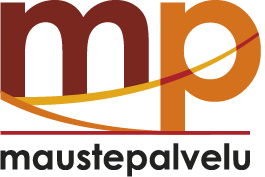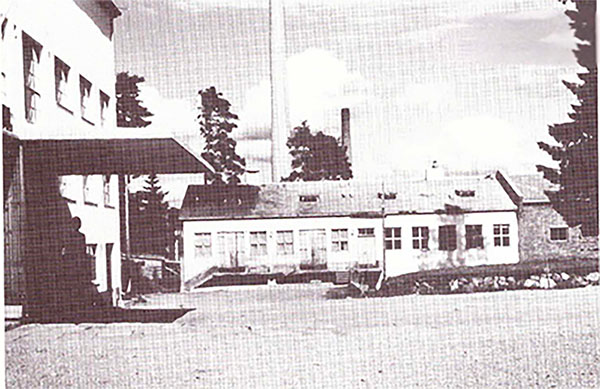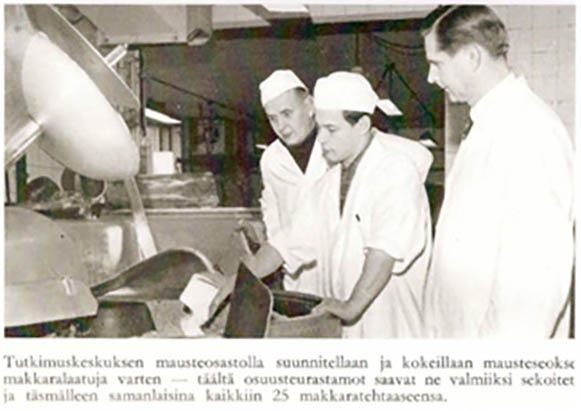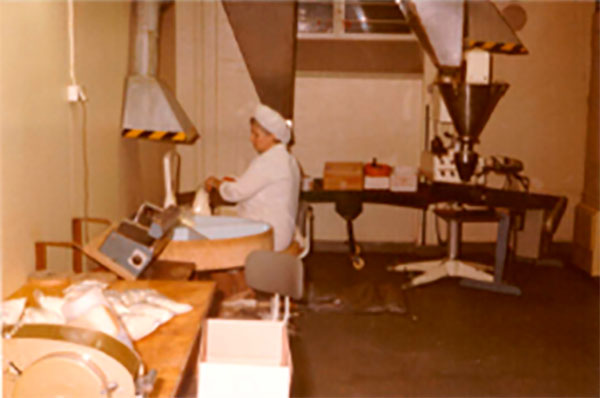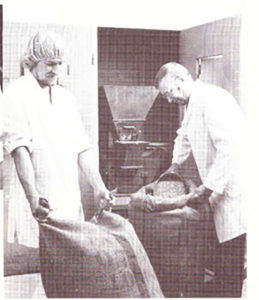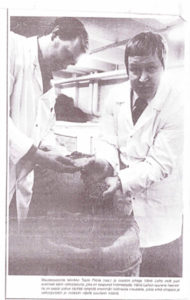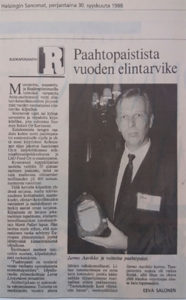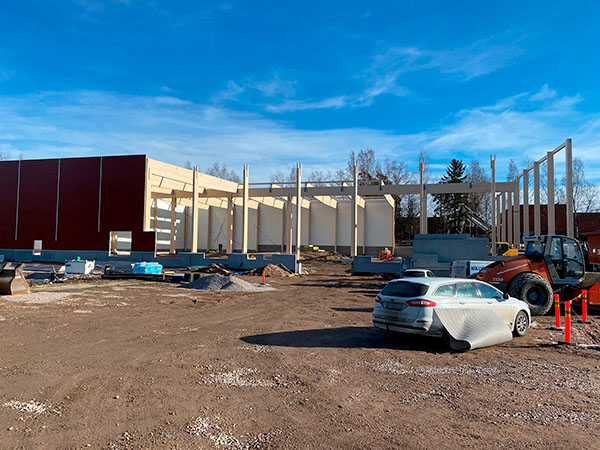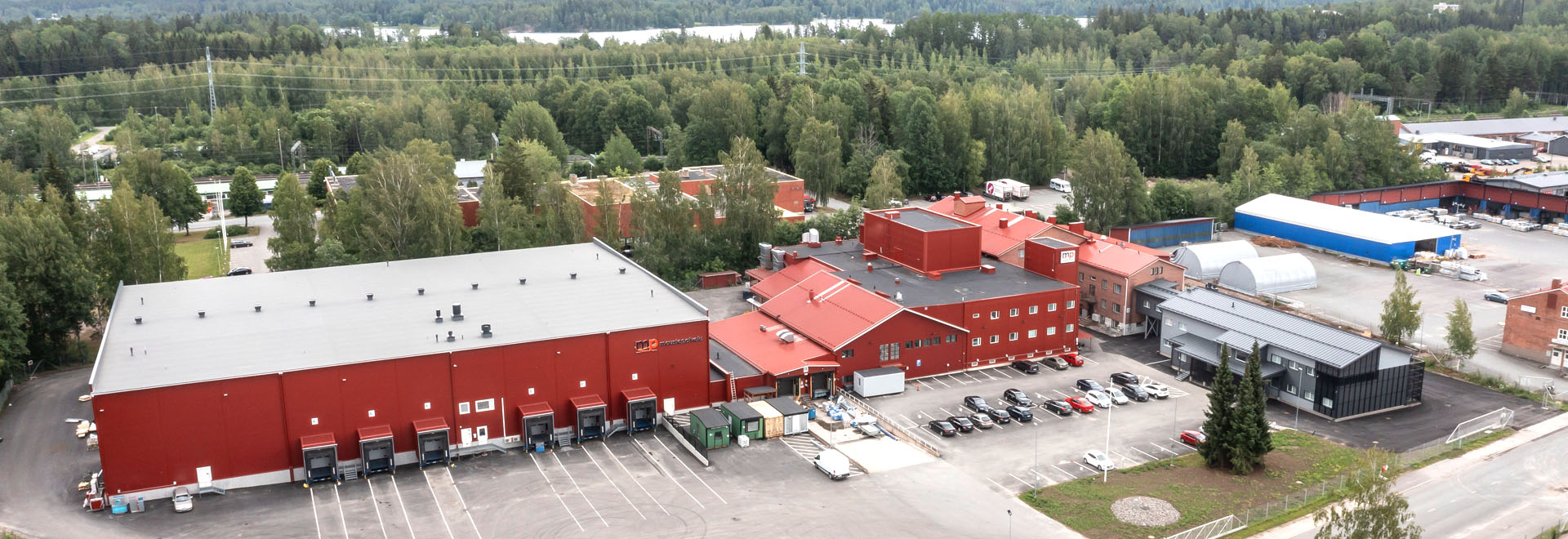
History
How did it all start?
Kemikalio- ja maustepalvelu began working with spices on 17 July 1948 under Osuusteurastamojen Tutkimuslaitos in Kuopio. Fritz “Piki” Niinivaara was chosen as the research institute’s director. The institute developed its own product to prevent blood coagulation – Verisuola (“blood salt”). Verisuola was patented in 1987, and it is still manufactured using almost the same recipe. Verisuola was followed by other products, such as an intestine bleaching agent and lohisuola (“salmon salt”).
Spice grinding begins
In 1951, the research institute delivered a total of 12,618 kg of chemicals and spices to cooperative slaughterhouses.
The research institute and Kemikalio- ja maustepalvelu moved from Kuopio to Hämeenlinna at the end of 1951 and in early 1952. Operations were resumed in the new premises in January 1952.
In the summer of 1952, the decision was made to start manufacturing and selling the company’s own phosphate additive mixtures for meat products, which turned out to be a great success story. The name given to the new product was Sitonal®.
Spice grinding became a key part of Kemikalio- ja maustepalvelu’s business operations. For this purpose, powerful new grinding mills were purchased. Spices in liquid form were introduced alongside the dry, ground spices, but these were discontinued in the early 1960s. Maustepalvelu took a new direction in the 1950s, developing, mixing and selling sausage spice mixtures.
Sausage spices, phosphate mixtures and their development took centre stage. Competition, especially in phosphates, was getting tougher on the market.
Establishment of Lihateollinen Tutkimuslaitos
Osuusteurastamojen Tutkimuslaitos was abolished on 16 August 1960, replaced by Lihateollinen Tutkimuslaitos ry (“Meat industry research institute”), LTK for short. All cooperative slaughterhouses and Tuottajain Lihakeskuskunta (“Meat producers’ central organisation”), TLK for short, joined as members. LTK’s owners were aiming for better-organised research, training, and technical development. They wanted to move the basic research into universities. This resulted in the establishment of LTK, divided into the following departments: bacteriological laboratory, analytical laboratory, and technological department + Kemikalio- ja maustepalvelu.
The sale of Kemikalio- ja maustepalvelu products was, right from its establishment, part of LTK’s sales and invoicing. For VAT reasons, this had to be changed. Purchases for Kemikalio- ja maustepalvelu were channelled through TLK’s supply department, as was the invoicing. This meant that Kemikalio- ja maustepalvelu worked as part of LTK and on its premises, as a unit that developed and manufactured products, while raw material purchases and the invoicing of completed products was handled through TLK. The financial proceeds from these operations went to TLK.
First Maustetoimikunta (“Spice committee”)
The first Maustetoimikunta convened in 1969, with the purpose of acting as a connection between and discussion forum for Kemikalio- ja maustepalvelu and users of the products.
Manufacture of mixtures for minced meat
The convenience food industry was developing fast, resulting in the development of product-specific spices for liver casserole, meatballs, blood pancakes and sauces, under the Atria brand. In 1972, raw material mixtures for convenience foods were introduced, and the manufacture of minced meat mixtures was started in 1974, the latter being one of the biggest success stories for Maustepalvelu. Minced meat mixtures were warmly welcomed in convenience food factories, and their sales and packaging volume skyrocketed.
First packaging machine and conical screw mixer
In 1973, it was discovered that the feeding and packaging of additives and mixtures by hand or with feeding equipment could no longer keep up with the increasing volumes, so an automatic packaging machine had to be obtained. Maustepalvelu purchased an automatic packaging machine, Hamac-Höller, equipped with a feeder, which was used until 1987. A Nautamix conical screw mixer was also purchased.
LTK’s name was changed to Lihateollisuuden Tutkimuskeskus ry (“Meat industry research centre”). The name Kemikalio- ja maustepalvelu was dropped and replaced by simply Maustepalvelu, and on 1 January 1982, Maustepalvelu was officially made into a TLK department operating under LTK.
Larger premises
JThe manufacture and delivery volumes of mixtures used for minced meat products increased steeply. In 1982, TLK leased old premises from Lounais-Suomen Osuusteurastamo (“Cooperative slaughterhouse of Southwest Finland”), LSO. The slaughterhouse operations had already been discontinued there earlier. Maustepalvelu used what had previously been the cowshed, slaughterhouse area, and cellar.
The raw materials were stored in the former cowshed, while the slaughterhouse area was well suited for the conical screw mixer. Later, another conical screw mixer was purchased. These premises are still used by Maustepalvelu, while the mixers were later moved into a production area created from a former LSO meat-cutting and service facility.
New spices on the market
The products introduced to the market included pizza spice, chicken BBQ sauce, new spicy sauces, and spices for the fillings of deep-fried stuffed pastries. For the packaging needs of GATRIAN spice products for commercial kitchens, a Pure Pak carton creation and sealing assembly line was obtained, complete with a screw feeder suitable for powdered products.
In 1985, work began on the development, tailoring, and sales of so-called Total-pack mixtures to customers. The Total-pack mixtures contained, for example, all spices, additives, and dry ingredients for any specific sausage.
Atria’s roast pork marinade is a success
At LTK, as part of joint product development with Atria products, uncooked whole-meat products ready for the oven were developed to make cooking easier for consumers. One particularly successful product was Porsaanpaisti á la Atria (Atria’s pork roast). This was spiced with a marinade developed by LTK’s product developed group, mixed, and packaged by Maustepalvelu. Marinade production started yet another success story in the commercial history of Maustepalvelu.
As the sale of marinades began to increase a lot, many customer companies began to wonder why they should transport oil, water and vinegar from Maustepalvelu to the customer companies. This is why many companies making marinated raw-meat products invested in marinade mixing equipment assisted by Maustepalvelu, with Maustepalvelu delivering tailored marinade mixtures to the companies.
New production and office building
As an extension to the production facilities, a new production and office building was designed for the plot leased from LSO. In 1985 and 1986, a production building of 670 square metres was constructed. In autumn 1986, all raw materials were moved into the new building, including mixing and packaging functions and offices from the LTK building.
Corporatisation initiates increased activity
In 1991, the local cooperative slaughterhouses decided to discontinue the operation of TLK. This eventually resulted in the creation of two competing meat companies, which are today called Atria Plc and HKScan Corporation.
A solution had to be found in order to continue the operation of Maustepalvelu, which had been operating as a department of TKL since 1982, and the decision was made to start a company called LTK-Maustepalvelu Oy, which continued the operations of TLK’s Maustepalvelu division. Maustepalvelu became, for the first time in its history, an independent company, with an owner, management and normal business opportunities.
Following corporatisation, Maustepalvelu began more active services for products, product development services, and tailored mixtures for Finland’s entire meat and convenience food sector. Maustepalvelu’s staff numbers increased significantly after corporatisation. Once they controlled the operations themselves, changes were also made in raw material purchase and supplier cooperation. This resulted in even closer cooperation with suppliers. Testing of and competitive tendering for ingredients began in earnest, and Maustepalvelu began to apply for representation or exclusive-sale products for the Finnish market.
Maustepalvelu expands even more
In 1993, Maustepalvelu bought all the 1950s buildings at Luukkaankatu 6, Hämeenlinna, and the following year, also the plot from LSO. This meant that Maustepalvelu was now using the property of a former slaughterhouse, meat cutting plant and sausage factory, and a production facility completed in 1986.
Maustepalvelu’s production and sales volumes continued to grow fast, so a three-storey extension was built in 1995, combining the old 1950s brick building with the production facility built in 1986.
First quality certificate
Maustepalvelu was granted its first quality certificate in 1998.
In 1999, Maustepalvelu’s net sales were approximately 90 million Finnish markka, with a staff of 43. More than 400 raw materials were already being used.
Greater focus on quality work
More and more was invested in quality aspects of the work in the 2000s. An HACCP self-monitoring project was started to complement the ISO 9901 quality system already granted to Maustepalvelu.
A new test factory was completed in 2001 on the premises of a former meat museum. This contributed to the product development and marketing of the convenience food sector in particular. The office premises were expanded further in 2000 by building a warehouse for outgoing goods. In addition to this, the raw materials receiving area on the east side was expanded by building an off-loading bay and a raw material storage area.
The number of raw materials increased to 500 items. Product development was expanded to include functional foods and their ingredients.
Construction of environmental system
In 2002, an environmental certificate complying with ISO 140011 was awarded to the company. Maustepalvelu set a target that 60% of its waste should be combustible energy waste.
Name change
The same year, the company wanted to change its business name, LTK-Maustepalvelu Oy, getting rid of the confusing LTK part, and since 19 November 2002, the company’s name has been MP-Maustepalvelu Oy.
In 2007, the company’s net sales exceeded EUR 20 million.
The number of raw material product names continued to rise steeply, as did the number of tailored mixtures. The production facilities and machinery were again expanded by investments of EUR 4 million in 2011–2012.
Maustepalvelu changes to Barentz ownership
LTK’s owner members decided to discontinue the operation of the research centre. The name of Lihateollisuuden Tutkimuskeskus ry had already been changed to Lihateollisuuden Tutkimuskeskus LTK Osuuskunta. LTK Osuuskunta sold all the shares of its subsidiary MP-Maustepalvelu Oy to the Dutch company Barentz. Lihateollisuuden Tutkimuskeskus was discontinued in 2014. However, Maustepalvelu’s operations continued, with the new management seeking more growth and expanding abroad.
New certificate and growing operations
In 2016, Maustepalvelu’s net sales totalled EUR 23.3 million, employing almost 70 people in Hämeenlinna. The same year, Maustepalvelu also received the FSSC 22000 certificate.
On 31 August 2017, Maustepalvelu bought Leipurin Plc’s meat industry operations, significantly improving Maustepalvelu’s opportunities to offer new raw materials and product information to existing and new customers.
In 2018, net sales exceeded EUR 30 million.
Investment plans
In 2021, Maustepalvelu began a new expansion as part of a larger investment plan. New premises were leased in Hämeenlinna, comprising thousands of square metres in the Kantola industrial area. Construction began in Luukkaankatu, next to the existing premises, for a 12-metre-high logistics and warehouse building.
The Maustepalvelu investment plan will be continued in 2022–2024. Maustepalvelu will invest in higher growth and quality by, for example, buying new mixing equipment and by changing production methods. Production will take better account of allergens in particular, and management of contamination by them.
Changes in Maustepalvelu’s operational structures
Barentz group made some changes in the internal structures of operations in MP-Maustepalvelu Oy:n and Casmo Oy. Casmo Oy, owned by Barentz, changed its name to Barentz Finland Oy on 1 January 2022, focusing in future on the sale of its own raw materials and those of Barentz’s clients, and on the development of these operations. Maustepalvelu, on the other hand, will focus on its core expertise, spice mixtures and the development of such operations in Finland, and specific export sectors.
Wind energy
Maustepalvelu’s first sustainability report was completed in 2019, since when sustainability issues have been in focus more and more. In August 2021, for example, Maustepalvelu went over to using only wind energy, contributing to a key component of its sustainability goals, management of energy consumption.
New logistics and warehouse building
In August 2021, Maustepalvelu completed a 12-metre-high logistics and warehouse building in Hämeenlinna, in the Kantola industrial area. The new premises will enable Maustepalvelu to work even more efficiently and grow its business. The new premises will have warehouses for both raw materials and outgoing goods.
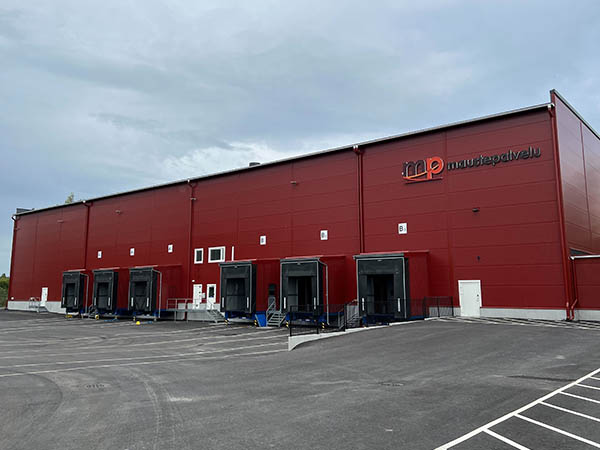
In 2022, Maustepalvelu has in its warehouse more than 1,000 raw materials, 1,800 items, and 13 production lines, with 80 staff members and net sales of about EUR 33 million.
This historical review is based on background work done by Maustepalvelu’s former managing director, Jarmo Aavikko.


